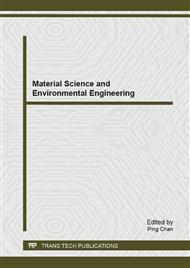[1]
Langlais B., Reckhow D. A., Brink D. R. (1991) Ozone in water treatment – application and engineering, Lewis Publisher.
Google Scholar
[2]
Rhee D. S., Jung Y. R. (2000) Characterization of humic acid in the chemical oxidation technology (II) – characteristics by ozonation, Analytical Science & Technology, 13(2), 241-249.
Google Scholar
[3]
Santos E. B. H, Duarte A. C. (1998) The influence of pulp and paper mill effluents on the composition of the humic fraction of aquatic organic matter, Wat. Res., 32(3), 597-608.
DOI: 10.1016/s0043-1354(97)00301-1
Google Scholar
[4]
Watt B. E., Malcolm R. L., Hayes M. H. B., Clark N. W., Chipman J. K. (1996) Chemistry and potential mutagenicity of humic substances in waters from different water sheds in Britain and Ireland, Wat. Res., 30(6), 1502-1516.
DOI: 10.1016/0043-1354(95)00319-3
Google Scholar
[5]
Brunet R., Bourbigot M. M., Dore M. (1984), Oxidation of organic compounds through the combination ozone-hydrogen peroxide, Ozone Sci. & Eng., 6, 163-183.
DOI: 10.1080/01919518408551019
Google Scholar
[6]
Gagnon G. A., Booth S. D. J., Peldszus S., Mutti D., Smith F., Huck P. M. (1997) Carboxylic acids : Formation and removal in full-scale plants, Journal AWWA, 89(8), 88-97.
DOI: 10.1002/j.1551-8833.1997.tb08279.x
Google Scholar
[7]
Nakamuro K., Ueno H., Kakao M., Sayato Y. (1990) Formation of hydrogen peroxide by aqueous ozonation of humic acid and aromatic hydrocarbons, Chemosphere, 20(5), 525-531.
DOI: 10.1016/0045-6535(90)90109-7
Google Scholar
[8]
Staeheiln J., Hoigne J. (1982) Decomposition of ozone in water : rate of initiation by hydroxide ion and hydrogen peroxide, Environ. Sci. Technol., 16, 676-681.
DOI: 10.1021/es00104a009
Google Scholar
[9]
Volk C., Roche P., Joret J. C., Paillard H. (1997) Comparison of the effect of ozone, ozone-hydrogen peroxide system and catalytic ozone on the biodegradable organic matter of a fulvic acid solution, Wat. Res., 31(3), 650-656.
DOI: 10.1016/s0043-1354(96)00302-8
Google Scholar
[10]
Glaze W. H., Kang J. W., Chapin D. H. (1987) The chemistry of water treatment processes involving ozone, hydrogen peroxide and ultraviolet radiation, Ozone Sci. & Eng., 9, 335-352.
DOI: 10.1080/01919518708552148
Google Scholar
[11]
EPA Guidance Manual - Alternative disinfectant and oxidancts (1999).
Google Scholar
[12]
Lim Y. S., Lee J. J., Rhee D. S. (1999) A study on the formation of formaldehyde from humic acid by ozonation", Research report (The institute of industrial technology, kangwon Nat, l univ. ), 19, 409-413.
Google Scholar


